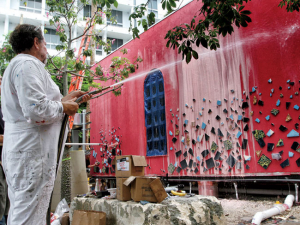Million-dollar Koons sculptures and designs by Schnabel—it’s all part of the collaboration between art and Miami’s expanding real estate boom.
The art scene in Miami continues to grow at an extraordinary pace, so much so that for many residents living in some of the most high-end buildings in the world, a trip to the museum isn’t always necessary for a daily dose of creativity. Developers are engaging major artists in large-scale collaborations, raising the aesthetic bar at their latest projects and putting installations and one-of-a-kind pieces on display for inhabitants to enjoy.
In these new condo towers, art is a fundamental aspect of the entire project, and not just a colorful wall-hanging picked up at moment’s notice because it matched the drapes; these are big new vertical Xanadus dripping in art. Everyone is trying to outdo one another—Faena House, developed by Alan Faena, will house the Faena Bazaar and an artist-in-residence center by Rem Koolhaas and OMA, while Oceana Bal Harbour will feature two larger-than-life works by Jeff Koons—Pluto and Proserpina and Ballerina, purchased in 2013 for $14 million—both of which will be shared and owned by building tenants. 250 Wynwood—an 11-unit condo developed by Fortis, will feature terrace overhangs decorated with curated graffiti. Not far away, the Filling Station Lofts in Wynwood has enlisted local artist Daniel Fila to create unique works of art for each individual floor, as well as to consult on the building’s aesthetics.

Rendering of entrance of Muse Residences in Sunny Isles Beach. Building will feature custom artworks by Helidon Xhixha in every unit
Up in Sunny Isles Beach, Property Markets Group’s Muse Residences—47 stories with 68 units—will deliver a custom $200,000 piece of art by Helidon Xhixha, created after consultation with the owner, into every $4 million-and-up unit. CMC Group is developing Brickell Flatiron on a wedge-shaped site at the convergence of South Miami Avenue and Southeast First Avenue. Besides its shape, the Brickell Flatiron building’s single most distinctive feature is an extensive and very public collaboration with the artist Julian Schnabel. CMC has Schnabel creating the spaces for the general public: the temporary sales center, the lobby, and the exterior, among others. Although not particularly huge, the sales center, built in adjacent Flatiron Park, is as lavish as Miami sales centers get (and that’s saying a lot). Along with filling the interior with his art, Schnabel has modeled the space after his famed home in New York. It’s Miami’s own miniature Palazzo Chupi, and a singular art installation in itself—perhaps Miami’s first “museum-quality” condominium sales center. And if that’s not enough, CMC is sponsoring an actual museum exhibition of Schnabel’s work, at Fort Lauderdale’s NSU Museum of Art, curated by the incomparable Bonnie Clearwater. “The goal is to involve the public,” says Vanessa Grout, president of CMC Real Estate.
Over at The Related Group, Art Director Patricia Hanna is tasked with creating the art collections that adorn every luxury condominium project that the company builds. And in Miami, they’re all considered luxury. Hanna and Related head Jorge Pérez have fostered a partnership with the National YoungArts Foundation that should blossom in all sorts of interesting ways. YoungArts scholarship recipients will have their work displayed within Related projects, including at the sculpture garden at Icon Bay, a condominium tower near the new YoungArts campus. And an artists-in-residency program will house at least three artists a year in Related condos. Other Related buildings with their own collections include One Ocean, which is currently under construction; Baltus House, which recently topped off; Brickell Heights and SLS Brickell, both of which broke ground earlier this year; and SLS Lux, which features a giant Botero statue in the sales center courtyard.
These developers are obviously considering way more than a return on investment when deciding to do “art.” They’re doing it because it’s good for Miami, but they’re only able to do it because in this economy it’s finally cost effective. “Fortunately Miami is experiencing a newly popular alignment between artistic ambition and financial incentives,” says Grout. “Private money is investing in art, which directly impacts the public good while providing a good return on investment.” Are developers doing it for the money? Not necessarily, but they couldn’t do all this without it.
Source: OceanDrive












